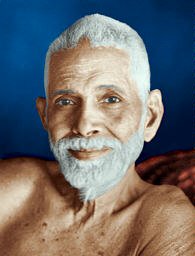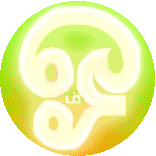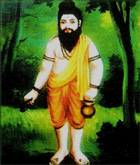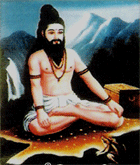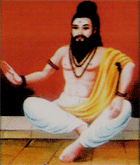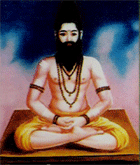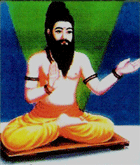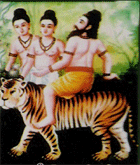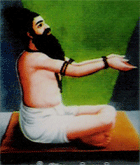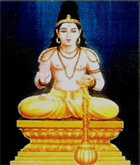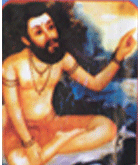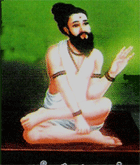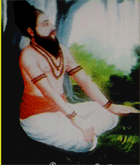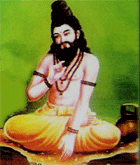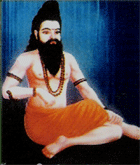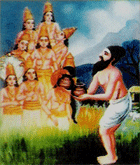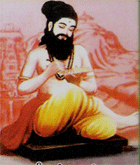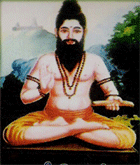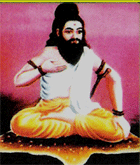In old
Tamil, "Siththu"
means "of Siva",
thus Siththar refer to "the disciples of God Siva" . Legend
says that God Siva
and Lord Muruga
prescribed the sciences of the study of the eternal mind and the
perfection of health, and the science of Tamil traditional
medicine,
to their beloved disciple
Nanthi, the
saint Bull. Nanthi, in turn, taught sage
Agastya
these chapters and whence commenced the legacy of Siddhar monasteries.
Siddhars are saints in India, mostly of the Saivaite
denomination in Tamil Nadu, who professed and practised an unorthodox
type of Sadhana,
or spiritual practice, to attain liberation. They are people who are
believed to control and transcend the barriers of time and space by
meditation (Yoga),
after the use of substances called
Rasayanas
that transform the body to make it potentially deathless, and a
particular breathing-practice, a type of
Pranayama.
Through their practices they are believed to have reached stages of
insight which enabled them to tune into the powers hidden in various
material substances and practices, useful for suffering and ignorant
mankind. Typically Siddhars were saints, doctors, alchemists and
mysticists all at once. They wrote their findings, in the form of
poems in Tamil language, on
palm leaf
which are collected and stored in what are known today as
Palm leaf manuscript, today still owned by private families in
Tamil Nadu and handed down through the generations, as well as public
institutions such as Universities the world over (India, Germany,
Great Britain, U.S.A.).
In this way Siddhars developed, among other branches of a vast
knowledge-system, what is now known as
Siddha
medicine, practised mainly in Tamil Nadu as Traditional native
medicine.
Easier and common medications from
Siddha
medicine has since been practised by experienced elderly in the
villages of Tamil Nadu, and is popularly known as Paatti Vaitthiyam,
Naattu marunthu and Mooligai marutthuvam They are also
founders of
Varmam - a martial art for self-defence and medical treatment at
the same time.
Varmams are specific points located in the human body which when
pressed in different ways can give various results, such as disabling
an attacker in self-defence, or balancing a physical condition as an
easy first-aid medical treatment.
Siddhars also wrote many religious poems.
One of the best-known Siddhars nowadays is
Patanjali,
the author of the
Yoga-Sutra.
Another prominent personality is
Agasthyar,
who is believed to be the founding father of Siddha culture.
Abithana Chintamani states Siddhars are either of the 9 or 18
persons enlisted, but sage
Agastyar
states that there are many who precede these and follow 9 or 18
persons. Many of the great Siddhars are regarded to have powers
magical and spiritual.
| |
| Sitthar
Karuvooraar, with his disciple Rajaraja Chola, found in the
Sanctum sanctorum of Peruvudaiyaar Koil, Thanjai, 10th c. CE |
All Sitthars were among the highest disciples
of God Siva,
and are considered equal in their powers and devotion to the supreme
God.
#Lord Nandi,
principal disciple of God Siva and Lord Muruga #Lord
Parasuram
of Vallam, head of Celloor monastery #Agastyar
from Anantasayana, head of the monasteries at Pothigai and Kumbakonam#Poagar
of Pazhani, disciple of Agastya, 6th c. BCE( rough estimate ) #Thaeraiyar
of Ten Pothigai, disciple of
Agastya, 6th
c. BCE #Korakkar
of Paerur, from Thirukonamalai monastery, ?4th c. BCE#Pulippaani
of Pazhani#Thadangann
Siddhar#BramhaMuni,
?3rd c. BCE #Machamuni
of Thirupparankundram, ?3rd c. BCE #Poonaikkannanaar
of Egypt, ?3rd c.BCE #Romamunivar
of Rome, ?2nd c. BCE#Kaaraichchiththar,
?2nd c.BCE#Kudhambai
Siddhar of Mayilaaduthurai and Kumbakonam, ?2nd c. BCE#Kabilar
I of Mithila, 2nd c. BCE.#Kaagaivanna
Siddhar
[i] of Kediya(South Sri Lanka), from Pothigai monastery, 2nd c.
BCE#Dhanvantri
from Kasi, of
Vaitheeswaran Koil, ?1st c. BCE#Valmiki,
aka
Vaanmeegar of Ettukkudi, ?1st c. BCE#Maarkkandeyanaar#Koonkannar#Kaalaichchittar
II #Konganar
of Thirupathi,
1st c. BCE#Punnaakkeesar
from Naangunaeri, head of Saanganachaeri monastery, 1st c. BCE#Kaalangicchitthar
of Kanchipuram, ?2nd c. CE#Kaaduvelichchiththar
#Aenaathichchittar,
2nd c. CE #Idaikkaadar
of Oosimuri(in Thondai Nadu), from ThiruAnnaamalai monastery, ?2nd-3rd
c. CE #Pulasthiyarfrom
Maanthai, head of Aavudaiyaar Koil and Yaazhppaanam monasteries, 3rd
c. CE#KamalaMuni
of Thiruvaarur, ?4th c. CE#Pathanjali
of Rameswaram, 4th c. CE #Azhaganiyaar
of Nagapattinam, ?4th c. CE#Kailasanathar,
5th c. CE #Kuranguchchittar
of Pazhani, 5th c. CE #Sattaimuni
of
ThiruArangam, ?5th c. CE #Vaamathevar
of Azhagarmalai, ?5th c. CE #Agappaei
Siddhar of Azhagarmalai, ?3rd c. CE #Sivavaakkiyar
from Kollimalai, of Thirumazhisai monastery, ?4-5th c. CE #Sundarandandar
of Madurai, ?5th c. CE#Ramadevar
of Azhagarmalai #Thirumoolar
from ThiruAaAduthurai, of ThiruAathavoor monastery, head of Thillai
Citrambalam[i]
monastery, 6th c. CE#Sri
Jnyaaneswar of Gujarat#Later Siddhars include -Thirujnana
Sambanthar, 7th c. CE #Arunagirinaathar
of ThiruAnnaamalai, 7th c. CE#Kaagapusundar,
disciple of Thirujnana Sambanthar, 7th c. CE #VaasaMuni#KoormaMuni#Kumbhamuni#Nandeeswarar
of Kasi, from Thillai monastery, 6th c. CE #Pattinattaar
of Pugaar, 7th c. CE #Avvaiyaar
III, ?8th c. CE #Karuvoorar
from Karuvoor, of Thanjai monastery, master of Rajaraja Chola, 10th c.
CE#Pambatti
Siddhar from Jnaneswaram( near Dwaraka, in Gujarat ), of
Vilaimalai( Vriddhachalam ) monastery, 15th c. CE #Vaalaichchaami
of Valangaimaan#Edaikadar
II, ?15th c. CE#Ganapathi
Siddhar#Subrahmanya
Siddhar #Sooriyaananthar#Lokaayuthar#Bathragiriyaar
of Badrachalam, from Thillai monastery #Kaesayogi
of Badri-Khedarnath#Sri
Ramana Magarishi of ThiruAnnaamalai, 19th c. CE
The 9 list as Abithana Chintamani states is as follows:
#Sathyanathar#Sadhoganathar#Aadhinathar#Anadhinathar#Vegulinathar#Madhanganathar#Machaendranathar#Gadaendranathar
or
Gajendranathar#Korakkanathar
The 18-list of siddhars is:
#Agastyar#Bogar#Korakkar#Kailasanathar#SattaiMuni#Tirumoolar#Nandhi#Koonkannar#Konganar#MachaMuni#VaasaMuni#KoormaMuni#Edaikaadar#KamalaMuni#Punnakeesar#Sundarandandar#Romarishi#BramhaMuni
The siddhars are believed to have had powers
both major and other ‘minor’ powers. They are explained in detail in
various yogic as well as religious texts;Thirumandiram 668:
#To become tiny as the
atom within the
atom (Anima)#To become big in unshakeable proportions (Mahima)#To
become as light as
vapour in
levitation
(Laghima)#To become as heavy as the
mountain (Garima)#To
enter into other bodies in transmigration (Prapti)#To be in all
things,omni-pervasive (Prakamya)#To be lord of all creation in
omnipotence (Isatvam)#To be everywhere in omnipresence (Vasitvam)
These eight are the Great Siddhis.
Reference for the above statements:http://en.allexperts.com/e/s/si/siddhar.htm
|
|

